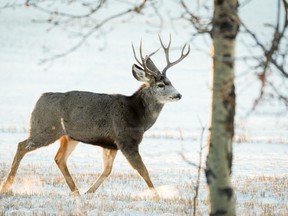Lead author lead author Dr. Cole Burton says there was a lot of variation in how animals moved around during the pandemic

Article content
We’ve all heard the tales of animals returning to urban areas while humans sheltered in place during the COVID-19 pandemic. Dolphins returned to coastlines. Goats, coyotes and raccoons reclaimed the streets.
But UBC scientists say overall those romantic notions of wildlife “running free” in lockdowns may have been overblown.
Article content
Using a network of 5,000 cameras around the world, more than 220 researchers studied the movement of 163 mammal species over the pandemic, or anthropause, a term coined by scientists in discussing the positive impact of the COVID-19 lockdown on wildlife and the environment.
Advertisement 2
Article content
The UBC-led study, published Monday in Nature Ecology and Evolution, is one of the largest of its kind. Researchers used data from before and during the COVID-19 lockdowns (between March 2020 and January 2021) to examine wildlife behaviour amid changing human activity levels.
While larger prey animals, such as deer and moose, became more active in some urban settings, predators like wolves and cougars tended to avoid these areas, according to lead researcher Dr. Cole Burton, an associate professor of forest resources management at UBC.
This may suggest that as predators retreat from communities, prey animals may be realizing it’s a bit safer around humans, said Burton.
And in many cases, there was an increase in human activity, for example, in parks and mountains, which could explain why many predators retreated. This was true for many of the Canadian sites researched, including Banff in Alberta and B.C.’s Pacific Rim, Cathedral, Golden Ears and South Chilcotin Mountains provincial parks, and the Sea to Sky corridor.
“We did see cases where there was more animal activity where there were fewer people. But we also saw the reverse where there was actually less animal activity in some cases. So the patterns were much more complex, which led us to think a bit more about what really might be going on in these different situations,” said Burton, in an interview Friday.
Article content
Advertisement 3
Article content
He said studying animals that move over large areas has been hard to observe in the past because of the movement of people. But the pandemic offered a rare opportunity to see how the movement of animals altered when human activities drastically changed over a short period of time.
Improving wildlife monitoring systems and using tools such as camera traps can help scientists and policymakers determine which areas need to be protected — important information given the surge in outdoor recreation post-pandemic, he added.
“And contrary to the narratives that emerged during the pandemic, we did not see an overall pattern of wildlife running free … We realized that was probably a little simplistic and a lot of those early observations were somewhat anecdotal or from different types of sightings.”
Part of the challenge for the study was there was a lot of variation in lockdowns and human movement in different parts of the world.
“Sometimes when a park opened back up, we’d see this real flush of people using it and would be higher than it had been before the pandemic.”
Under higher human activity, mammals were less active in undeveloped areas but unexpectedly more active in developed areas while exhibiting more nocturnal habits, the study concludes.
Advertisement 4
Article content
Burton said more research will be done to take the big patterns that came out of this study and narrow them down. For example, looking at the impact on the predators that retreated and whether they are getting enough food as prey move closer to humans.
They will also look at different factors affecting their movement, such as the 2021 heat dome in B.C. and last year’s wildfires.
“With these wildlife cameras out there we can learn when some of these unexpected events happen,” he said.
“This gives us a glimpse into how much animals are working and trying to adapt to us and so I think hopefully we can learn from that so we can do our part and manage our own activities to coexist with them.”
Recommended from Editorial
Bookmark our website and support our journalism: Don’t miss the news you need to know — add VancouverSun.com and TheProvince.com to your bookmarks and sign up for our newsletters here.
You can also support our journalism by becoming a digital subscriber: For just $14 a month, you can get unlimited access to The Vancouver Sun, The Province, National Post and 13 other Canadian news sites. Support us by subscribing today: The Vancouver Sun | The Province.
Article content





